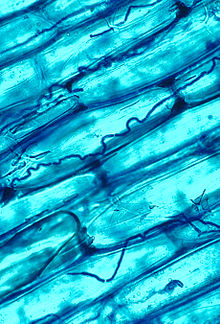Epichloë
For most of their life cycle however, Epichloë grow in the intercellular space of stems, leaves, inflorescences, and seeds of the grass plant without incurring symptoms of disease.In fact, they provide several benefits to their host, including the production of different herbivore-deterring alkaloids, increased stress resistance, and growth promotion.The latter were previously placed in the form genus Neotyphodium but included in Epichloë after molecular phylogenetics had shown asexual and sexual species to be intermingled in a single clade.Grass varieties, especially of tall fescue and ryegrass, with symbiotic Epichloë endophyte strains, are commercialised and used for pasture and turf.[5] Several species from Africa and Asia that develop stromata on grasses were split off as a separate genus Parepichloe in 1998.[8] A number of species continued to be described in both genera until Leuchtmann and colleagues (2014) included most of the form genus Neotyphodium in Epichloë.[5] Phylogenetic studies had shown both genera to be intermingled, and the nomenclatural code required since 2011 that one single name be used for all stages of development of a fungal species.& Schardl Epichloë species are specialized to form and maintain systemic, constitutive (long-term) symbioses with plants, often with limited or no disease incurred on the host.stromata) is a mycelial cushion that gives rise first to asexual spores (conidia), then to the sexual fruiting bodies (ascocarps; perithecia).[10][11] Manifestation of the sexual state — which only occurs in Epichloë species — causes "choke disease", a condition in which grass inflorescences are engulfed by rapid fungal outgrowth forming a stroma.The fungal stroma suppresses host seed production and culminates in the ejection of meiospores (ascospores) that mediate horizontal (contagious) transmission of the fungus to new plants.This is suggested by phylogenetic studies indicating a preponderance of codivergence of Epichloë species with the grass hosts they inhabit.[14] Growth of the fungal symbiont is very tightly regulated within its grass host, indicated by a largely unbranched mycelial morphology and remarkable synchrony of grass leaf and hyphal extension of the fungus;[15][16] the latter seems to occur via a mechanism that involves stretch-induced or intercalary elongation of the endophyte's hyphae, a process so far not found in any other fungal species, indicating specialized adaptation of the fungus to the dynamic growth environment inside its host.[17] A complex NADPH oxidase enzyme-based ROS-generating system in Epichloë species is indispensable for maintenance of this growth synchrony.[25] Among the most abundant ergot alkaloids in epichloë-symbiotic grasses is ergovaline, comprising an ergoline moiety attached to a bicyclic tripeptide containing the amino acids L-proline, L-alanine, and L-valine.Key genes and enzymes for ergot alkaloid biosynthesis have been identified in epichloae and include dmaW, encoding dimethylallyl-tryptophan synthase and lpsA, a non-ribosomal peptide synthetase.[25] Another group of epichloë alkaloids are the indole-diterpenoids, such as lolitrem B, which are produced from the activity of several enzymes, including prenyltransferases and various monooxygenases.[22] Peramine is a pyrrolopyrazine alkaloid thought to be biosynthesized from the guanidinium-group-containing amino acid L-arginine, and pyrrolidine-5-carboxylate, a precursor of L-proline,[27][28] and is an insect-feeding deterrent.[28] The loline alkaloids[29] are 1-aminopyrrolizidines with an oxygen atom linking bridgehead carbons 2 and 7, and are biosynthesized from the amino acids L-proline and L-homoserine.[22] Recently it has been shown that Epichloë uncinata infection and loline content afford × Festulolium grasses protection from black beetle (Heteronychus arator).[34] In fact, some positive effects of epichloae on their host plants include increased growth, drought tolerance, and herbivore and pathogen resistance.[22] Although grass-epichloë symbioses have been widely recognized to be mutualistic in many wild and cultivated grasses, the interactions can be highly variable and sometimes antagonistic, especially under nutrient-poor conditions in the soil.[10][37] Some studies suggest a relationship between grazing by herbivores and increased epichloë infestation of the grasses on which they feed,[38][39] whereas others indicate a complex interplay between plant species and fungal symbionts in response to herbivory or environmental conditions.



Epichloë typhinabluegrassScientific classificationEukaryotaAscomycotaSordariomycetesHypocrealesClavicipitaceaeBalansiaeType speciesDiversitySynonymsascomyceteendophyticsymbiosisgrassestillershost plantinflorescencealkaloidsplant pathogenicteleomorphicasexualanamorphicform genusNeotyphodiummolecular phylogeneticsHybrid speciationplant communitiesfood webstall fescueryegrasspastureElias FriessubgenusCordycepsCordyceps typhinaChristiaan Hendrik PersoonCharlesLouis René TulasneParepichloeanamorphsAcremoniummolecular phylogeneticpolyphyleticnomenclatural codeN. chilensesubspeciesvarietiesEpichloë amarillansAgrostis perennansCalamagrostis canadensisElymus virginicusSphenopholis obtusataAmmophila breviligulataEpichloë aotearoaeEpichloë baconiiAgrostis capillarisAgrostis stoloniferaEpichloë brachyelytriBrachyelytrum erectumEpichloë bromicolaBromus erectusElymus repensBromus benekeniiBromus ramosusHordelymus europaeusHordeum brevisubulatumLeymus chinensisCalamagrostis villosaCalamagrostis variaCalamagrostis purpureaEpichloë elymiBromus kalmiiElymusElymus hystrixEpichloë festucaeFestucaKoeleriaSchedonorusEpichloë festucae var. loliiLolium perenne subsp. perenneEpichloë gansuensisAchnatherum pekinenseEpichloë inebriansEpichloë glyceriaeGlyceriaEpichloë mollisHolcus mollisEpichloë scottiiMelica unifloraEpichloë sibiricaEpichloë stromatolongaCalamagrostis epigejosEpichloë sylvaticaBrachypodium sylvaticumEpichloë sylvatica subsp. pollinensisPuccinellia distansAnthoxanthum odoratumBrachypodium pinnatumDactylis glomerataLolium perenneMilium effusumPhleum pratensePoa trivialisEpichloë clarkiiHolcus lanatusEpichloë poaePoa nemoralisPoa pratensisPoa secunda subsp. juncifoliaEpichloë poae var. aonikenkanaEpichloë poae var. canariensisEpichloë poae var. huerfanaFestuca arizonicaEpichloë alsodesEpichloë typhina subsp. poaeEpichloë australiensisEpichloë cabraliiPhleum alpinumEpichloë canadensisElymus canadensisEpichloë chisosaEpichloë coenophialaLoliumEpichloë typhina complex